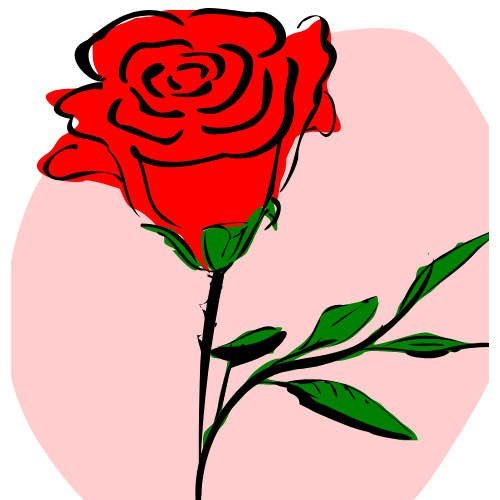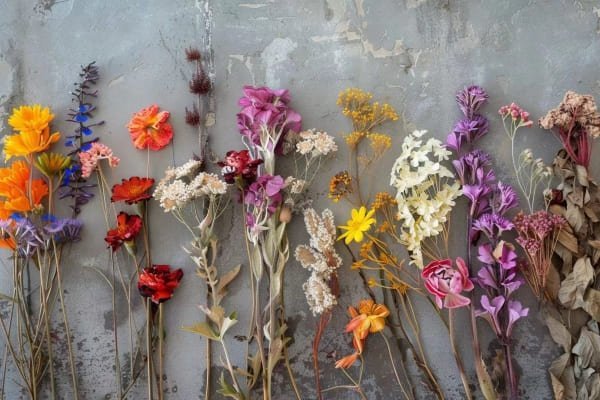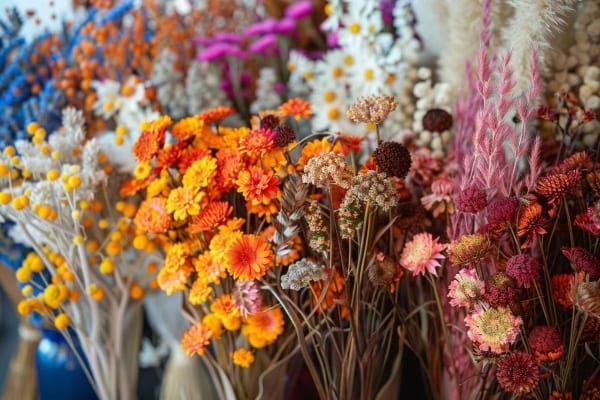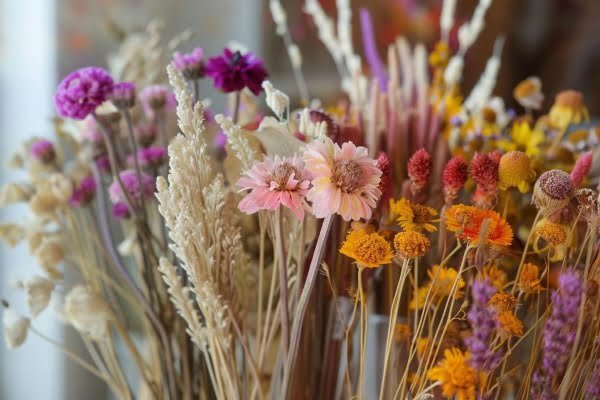Dried flower art has gained renewed popularity as a way to preserve the ephemeral beauty of blooms and turn them into lasting keepsakes. From stunning wall art and intricate framed arrangements to elegant home decor and unique gifts, dried flower art offers a creative way to immortalize nature’s beauty. This comprehensive guide will delve into the world of dried flower art, exploring techniques, materials, and creative ideas to help you transform your favorite flowers into timeless treasures.
1. Understanding Dried Flower Art
a. The Appeal of Dried Flowers
Dried flowers have a unique aesthetic that sets them apart from fresh blooms. Their preserved state captures the essence of the flowers while giving them a vintage or rustic charm. The process of drying flowers not only extends their beauty but also allows for creative exploration in art and decor.
b. Benefits of Dried Flower Art
- Longevity: Unlike fresh flowers that wilt and fade, dried flowers maintain their appearance for months or even years, making them perfect for keepsakes.
- Customization: Dried flower art allows for personalized creations that reflect your taste and style.
- Eco-Friendly: Utilizing dried flowers reduces waste and promotes sustainable practices in art and decor.
2. Choosing the Right Flowers for Dried Flower Art
Not all flowers are created equal when it comes to drying and preservation. Selecting the right types of flowers can make a significant difference in the quality and longevity of your dried flower art.
a. Popular Flowers for Dried Art
- Roses: Known for their timeless beauty, dried roses retain their shape and color exceptionally well.
- Lavender: With its soothing scent and delicate blooms, lavender adds both visual and aromatic appeal.
- Hydrangeas: Their large, full blooms make them ideal for creating dramatic and textured arrangements.
- Baby’s Breath: This flower adds a delicate, airy quality to arrangements and pairs well with other dried flowers.
- Poppies: Their bold colors and unique shapes create striking focal points in dried flower art.
b. Tips for Selecting and Preparing Flowers
- Harvest at the Right Time: Pick flowers when they are fully bloomed but not yet past their prime. For some flowers, this may be just before full bloom.
- Avoid Pesticides: Ensure that the flowers you choose are free from pesticides or chemicals, as these can affect the drying process and longevity.
- Drying Methods: Different flowers may require different drying methods, including air drying, pressing, or using silica gel.
3. Techniques for Drying Flowers
Proper drying techniques are crucial for preserving the flowers' color, shape, and texture. Here are some common methods:
a. Air Drying
- Process: Gather flowers into small bunches and tie the stems together with string or rubber bands. Hang the bunches upside down in a dry, dark, and well-ventilated area.
- Advantages: This method is simple and requires minimal equipment. It helps preserve the natural shape and color of the flowers.
- Considerations: Air drying may take several weeks and is best for flowers with sturdy stems.
b. Pressing
- Process: Place flowers between sheets of parchment paper and press them using a flower press or heavy books. Leave them for a few weeks until completely dried.
- Advantages: Pressing is ideal for flowers with flat, delicate petals and is useful for creating detailed designs.
- Considerations: Pressed flowers can become fragile and may require careful handling.
c. Silica Gel Drying
- Process: Bury flowers in a container filled with silica gel. The gel absorbs moisture and helps preserve the flower’s color and shape.
- Advantages: Silica gel drying is faster than air drying and helps maintain vibrant colors.
- Considerations: Silica gel can be expensive and may require careful handling to avoid damaging the flowers.
4. Creating Dried Flower Art
Once your flowers are dried and prepared, you can start creating beautiful art pieces. Here are some popular methods and projects:
a. Framed Flower Art
- Materials Needed:
- Dried flowers
- Picture frame
- Background paper or fabric
- Glue or mounting tape
- Steps:
- Prepare the Frame: Choose a frame that complements your decor. Remove the glass and backing.
- Create the Background: Cut a piece of background paper or fabric to fit the frame.
- Arrange the Flowers: Lay out the dried flowers on the background, experimenting with different arrangements.
- Secure and Frame: Glue or tape the flowers in place and reassemble the frame. Hang the art on your wall.
b. Flower Pressed Art
- Materials Needed:
- Pressed flowers
- Canvas or wooden board
- Mod Podge or clear adhesive
- Paintbrush
- Steps:
- Prepare the Surface: Apply a thin layer of Mod Podge to the canvas or board.
- Arrange the Pressed Flowers: Place the pressed flowers on the surface in your desired pattern.
- Seal the Artwork: Apply another layer of Mod Podge over the flowers to seal and protect them. Allow it to dry.
c. Dried Flower Wreaths
- Materials Needed:
- Dried flowers
- Wreath frame (wire or foam)
- Floral wire or hot glue
- Ribbon (optional)
- Steps:
- Prepare the Wreath Frame: Cover the frame with floral tape or moss for added texture.
- Arrange the Flowers: Position the dried flowers around the frame, creating a balanced design.
- Attach the Flowers: Secure the flowers with floral wire or hot glue.
- Add a Ribbon: Tie a ribbon around the top of the wreath for hanging.
d. Dried Flower Shadow Boxes
- Materials Needed:
- Dried flowers
- Shadow box frame
- Background paper or fabric
- Glue or mounting tape
- Steps:
- Prepare the Shadow Box: Open the shadow box and prepare the background.
- Arrange the Flowers: Position the dried flowers inside the shadow box, creating a three-dimensional effect.
- Secure and Close: Glue or tape the flowers in place and close the shadow box.
e. Dried Flower Jewelry
- Materials Needed:
- Dried flowers
- Resin or jewelry-making supplies
- Molds or bezels
- Steps:
- Prepare the Flowers: Cut small pieces of dried flowers to fit into jewelry molds.
- Create Resin Pieces: Mix resin according to the manufacturer’s instructions and pour it into molds with the flower pieces.
- Cure and Assemble: Allow the resin to cure, then assemble your jewelry pieces with chains or clasps.
5. Incorporating Dried Flower Art into Home Decor
Dried flower art can enhance various areas of your home. Here are some ideas for incorporating these beautiful creations into your decor:
a. Wall Art
Dried flower wall art adds a touch of nature to your living space. Create a gallery wall featuring framed flower art or large-scale botanical prints.
b. Table Centerpieces
Use dried flower arrangements as table centerpieces for a touch of elegance and natural beauty. Combine them with candles or seasonal accents for added interest.
c. Home Accents
Dried flower art can be used in various home accents, such as decorative bowls, bookends, or lamp bases. These unique pieces add personality and charm to any room.
d. Gifts and Favors
Dried flower art makes thoughtful and personalized gifts. Consider creating custom framed art, jewelry, or decor pieces for special occasions such as weddings, anniversaries, or birthdays.
6. Caring for and Maintaining Dried Flower Art
To ensure the longevity of your dried flower art, follow these care and maintenance tips:
a. Dusting and Cleaning
Regularly dust your dried flower art with a soft brush or a can of compressed air. Avoid using water or cleaning products, as these can damage the flowers.
b. Storage
If you need to store your dried flower art, keep it in a cool, dry place away from direct sunlight and humidity. Use protective coverings, such as glass or acrylic frames, to shield the artwork from dust and environmental factors.
c. Repairing Damage
If your dried flower art becomes damaged, you can often repair it by gently reattaching petals or replacing broken flowers. For significant damage, consider consulting a professional conservator.
7. Conclusion
Dried flower art is a beautiful and creative way to preserve the fleeting beauty of blooms and turn them into lasting keepsakes. Whether you’re creating framed art, wreaths, shadow boxes, or jewelry, dried flowers offer endless possibilities for artistic expression. By selecting the right flowers, using proper drying techniques, and incorporating creative ideas, you can transform nature’s beauty into timeless treasures that enhance your home decor and make meaningful gifts. Embrace the charm of dried flower art and celebrate the enduring allure of nature’s blooms.




